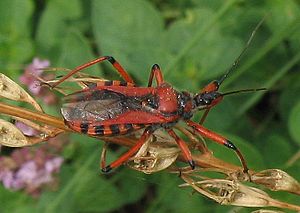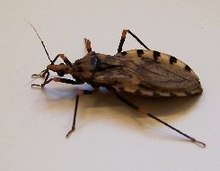Predatory bugs
| Predatory bugs | ||||||||||||
|---|---|---|---|---|---|---|---|---|---|---|---|---|

Red murder bug ( Rhynocoris iracundus ) |
||||||||||||
| Systematics | ||||||||||||
|
||||||||||||
| Scientific name | ||||||||||||
| Reduviidae | ||||||||||||
| Latreille , 1807 |
The predatory bugs (Reduviidae) are a family of the bugs (Heteroptera). They are distributed worldwide with about 7000 species . The German name indicates their exclusively predatory way of life. The bugs actively pursue their prey, primarily insects of all kinds, or wait for them to lie in wait for flowers or other places. Some predatory bugs, if harassed, can cause painful stings in humans, which rarely cause further discomfort in healthy people.
Distribution and habitats
Predatory bugs are common worldwide. They achieve the highest biodiversity in tropical - subtropical regions. They colonize almost all terrestrial, predominantly heat-favored habitats up to and including caves. The animals can be found on the ground, on flowers, in bushes and on trees. Some species live in human settlement areas in houses, barns and in attics.
Features and way of life




The species of predatory bugs vary considerably in size, shape and color. The largest Central European species, the dust bug ( Reduvius personatus ), reaches a body length of up to 19 millimeters. Other species, such as the genus Empicornis , only reach 3.5 to 5 millimeters. In contrast, predatory bugs live in tropical-subtropical regions and can grow to be several centimeters. Several species are delicately built, some are almost like mosquitoes . Other species are robust and vigorous like the species of the genus Rhynocoris . There are slim to very elongated, almost rod-shaped forms with long legs. For example the species of the genus Metapterus or Panstrongylus . Many species are well adapted to their surroundings through earth-colored tones of the body surfaces ( camouflage ). Other species wear warning robes and are often black and red or black and yellow in color. In some species the wings are reduced. The wings of numerous other species, on the other hand, are well developed and give them good flight ability. The hemi -ceilings ( hemielytres ) never have a cuneus and the membranes have several cells.
The freely movable head of the predatory bug is often elongated and constricted between the eyes or behind them, so that a rear neck-like head part is delimited. The antennae are always kneeled. The animals are mainly oriented optically with the help of their large compound eyes . Furthermore, in all long-winged forms there are two point eyes ( ocelli ) behind the antennae .
Predatory bugs have a short, three-part, strong and almost semicircular downwardly curved proboscis (rostrum), which does not touch the body at rest. Its tip can be moved back and forth on a longitudinal groove on the front chest between the front hips for the purpose of generating sounds. The sound production of the animals serves the defense; It is not known whether it is also used for intra-species communication. When the prey is pierced, saliva is injected, which paralyzes or kills the prey. The animals live exclusively predatory on various small arthropods . A specialization in certain groups of prey has not yet been established. Predatory bugs are active hunters and run around searching in the vegetation or often lurk on flowers in order to capture flower visitors. The legs of the predatory bugs are often very long. In many cases, the front legs have developed into catch legs with which they grasp and hold their prey. Some species have a cushion of dense hair on the front and middle rails, a so-called "sponge furrow" (Fossula spongiosa), which helps hold the prey. Few species of the subfamily Triatominae have evolved into bloodsuckers on mammals and birds , and sometimes also on humans.
Like all bedbugs, predatory bugs are hemimetabolic . The larvae develop through five larval stages separated by moults. The persistence of unfavorable seasons mainly occurs in the adult and larval stage. The generation time can be from less than a year to several years, depending on the geographical latitude and climate.
Medical importance
Blood-sucking Central American species of the family of bugs can transmit Chagas disease (or Chagas disease ) in humans . The parasitic unicellular organisms of the species Trypanosoma cruzi contained in the feces of these predatory bugs , which are mostly released at the same time near the puncture site, can get into the body by scratching and manipulating the puncture site and lead to disease.
Systematics
The predatory bug family consists of 25 subfamilies . There are 114 species in Europe. The Phymatinae are sometimes regarded as a separate family, the Phymatidae. The family of sickle bugs (Nabidae) was placed earlier to the predatory bugs due to their similar way of life, although there is no relationship between the two groups. About 7000 species are known worldwide. In Central Europe, the family of predatory bugs is represented with 20 mostly heat-loving species.
The predatory bugs (Reduviidae) are divided into the following 25 subfamilies:
- Bactrodinae Stål , 1866
- Centrocnemidinae Miller , 1956
- Cetherinae Jeannel , 1919
- Chryxinae Champion , 1898
- Ectrichodiinae Amyot & Serville , 1843
- Elasmodeminae Lethierry & Severin , 1896
- Emesinae Amyot & Serville , 1843
- Hammacerinae Stål , 1859
- Harpactorinae Amyot & Serville , 1843
- Holoptilinae Amyot & Serville , 1843
- Manangocorinae Miller , 1954
- Peiratinae Amyot & Serville , 1843
- Phimophorinae Handlirsch , 1897
- Phymatinae Laporte , 1832
- Physoderinae Miller , 1954
- Pseudocetherinae Villiers , 1963
- Reduviinae Latreille , 1807
- Saicinae Stål , 1859
- Salyavatinae Amyot & Serville , 1843
- Sphaeridopinae Amyot & Serville , 1843
- Stenopodainae Amyot & Serville , 1843
- Triatominae Jeannel , 1919
- Tribelocephalinae Stal , 1866
- Vesciinae Fracker & Bruner , 1924
- Visayanocorinae Miller , 1952
literature
- E. Wachmann , A. Melber, J. Deckert: Bugs. Volume 1: Revision of the bugs in Germany, Austria and German-speaking Switzerland. Goecke & Evers, Keltern 2006, pp. 216–244. ISBN 3-931374-49-1 .
- E. Wagner: Heteroptera Hemiptera. In: P. Brohmer, P. Ehrmann, G. Ulmer (Hrsg.): Die Tierwelt Mitteleuropas. Volume IV: Insects. Delivery 3 (Xa), Quelle & Meyer, Leipzig 1959.
- Kurt G. Günther, Hans-Joachim Hannemann, Fritz Hieke, Eberhard Königsmann, Hubert Schumann: Urania animal kingdom, insects . Urania-Verlag, Leipzig / Jena / Berlin 1994, ISBN 3-332-00498-0 .
- Jenaro Maldonado-Capriles: Systematic Catalog of the Reduviidae of the World (Insecta: Heteroptera) (= The Caribbean Journal of Science. Special Edition). University of Puerto Rico, Mayagüez 1990, pp. 694 ff.
Individual evidence
- ^ A b Maryn McKenna: Chagas Disease: Poverty, Immigration, and the 'New HIV / AIDS' . On: wired.com from May 30, 2012, last accessed on September 30, 2014.
- ↑ Reduviidae. Fauna Europaea, accessed July 26, 2007 .
- ↑ assassin and thread-legged bugs Reduviidae Latreille, 1807 . biolib. Retrieved January 28, 2017.